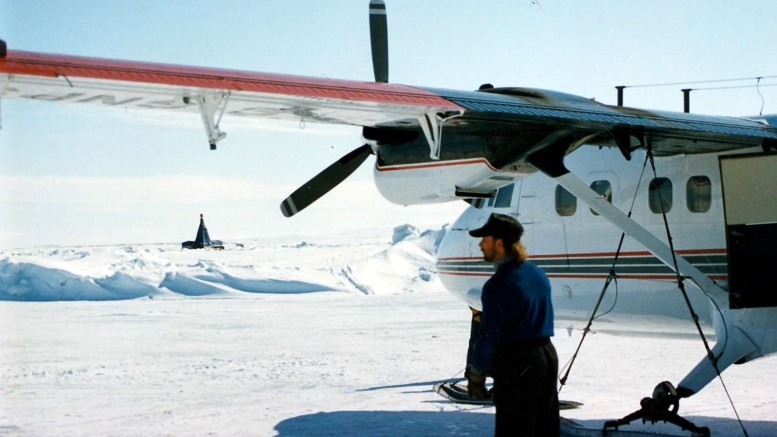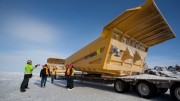On Nov. 6, 1991, the latest edition of The Northern Miner was on its way to bed when our fax machine spit out one page of seemingly unremarkable news: an obscure junior called Dia Met Minerals had discovered small diamonds somewhere in the Northwest Territories.
Already past our weekly deadline and unsure of how to handle a commodity as unfamiliar as diamonds, we banged off a couple of paragraphs describing the find and left it at that. Little did we know that the discovery was about to revolutionize an industry and create billions of dollars of wealth thanks to a small cast of interrelated characters.
In the days that followed, editor Jim Borland caught wind of the fact that several Australian and British dailies had reported the news and that Dia Met’s share price was heading north. Sure, Australian mining giant BHP-Utah Mines (now BHP Billiton [BLT-L, BHP-A]) was earning an interest in Dia Met’s properties, but it was routine for large companies to take option agreements on grassroots plays. There was something bigger going on.
Borland entrusted me with the task of digging deeper with a caveat to keep my skeptic’s hat on. After all, as the saying used to go, there is nothing as “false as Canadian diamonds” — a reference to Jacques Cartier’s “discovery” of worthless quartz in Quebec in 1541) and the mineral exploration industry had its share of charlatans.
But as we were scratching our heads in bewilderment and disbelief at The Northern Miner’s editorial office in the Don Mills area of Toronto, Ont., geologist Christopher Jennings was experiencing the opposite reaction.
“I was in London when the news broke, trying to raise money for my own company,” Jennings recalls. “A few days later, I got a call from Bob Gannicott, Lee Barker and Gren Thomas asking me what I thought of the release. I told them the news was highly significant, comparable to a one ounce gold discovery over a substantial thickness.”
The announcement came well before the Internet became a source of information, so telephone was the only way to check the story. My first call to the Dia Met office in Kelowna, B.C., was answered by Wayne Fipke, the brother of Dia Met cofounder Chuck Fipke. From the Dia Met office in Kelowna, B.C., Chuck Fipke’s brother Wayne took my first call. He exclaimed that it was unheard of to have so many diamonds (81) in such a small sample (59 kg) and that a massive staking rush was taking place in the Northwest Territories as a result.
His tone was so promotional that it was difficult to believe what he said, but further calls confirmed his story: juniors were scrambling to find helicopters in Yellowknife to fly them into the barrens, and millions of acres had already been staked near the discovery, 300 km northeast of the capital city.
Jennings appreciated the significance of Dia Met’s discovery because he had spent a good part of his career trying to convince Canadians — including mining majors Falconbridge and later International Corona — that, based on the geology of the area, there was an excellent chance of finding diamond mines in the Slave Province of the Northwest Territories.
“I would say so frequently in public talks and they would say I was just another mad South African,” Jennings says.
Fipke himself remembers a similar uphill battle trying to convince others that his plan to explore the arctic for diamonds was not a fool’s mission.
“People used to think you were a bit crazy,” Fipke recalled in a recent interview with Diamonds in Canada. “When I came up and proposed finding diamond mines in Canada, it was like somebody coming up to you and saying: ‘I’m going to walk on Mars,’ you know it was just b.s. — that was how it was perceived.”
Jennings had worked with Fipke and Hugo Dummett — another South African — when the pair were geologists with Falconbridge’s partner, Superior Oil. When Superior suspended its minerals program and Falconbridge turned its heels on diamond exploration in 1980s, Fipke struck out on his own with financial help from partner Stewart Blusson, Dummett went to work at BHP, and Jennings took a job with BP Minerals.
In those days, Jennings would get regular calls from Fipke about arranging a joint venture with BP to look for diamonds in the territories. But ultimately it was Dummett who was able to convince his superiors that Fipke was worth the risk. In 1990, BHP signed an option agreement with the notoriously quirky Fipke.
“It was Hugo who advanced the story more than anyone else could have because he put his career with BHP on the line by saying there will be diamonds in Canada and we need to do this deal,” says Bob Bishop, former editor of Gold Mining Stock Report and an early believer in the diamond story.
Dummett, a 2010 inductee into the Canadian Mining Hall of Fame, died in a car crash in South Africa in 2002. Fipke is now chairman of Cantex Mine Development (CD-V) and Metalex Ventures (MTX-V), and his contemporaries have nothing but praise for the man’s determination to follow his dreams in the face of physical and financial hardship.
“I give Chuck full credit for tenacity during the years of having no budgets and just a few friends financing him,” Jennings says. “It was a rush to get there first, and Chuck got there first.”
Jennings’ days as a company man ended abruptly when he infuriated his last employer, Corona, by sending geologist Leni Keough (now president and CEO of Olivut Resources [OLV-V]) — to the barrens to look for diamond indicator minerals without authorization. As Corona wound down its exploration business in the months ahead, exploration director Lee Barker followed Jennings, neither foreseeing that that they would work together again so soon.
“I knew what Fipke was doing and I tried to leapfrog him by sending Leni to Hudson’s Bay to work westward while Fipke was going eastward,” Jennings says. “Leni ended up at Exeter Lake at the edge of the Dia Met claims. She told me that the eskers there were full of indicator minerals, including the mauve garnets we were looking for.”
In July 1991 — just months before the Dia Met announcement — Jennings asked Corona for $100,000 for staking. The company refused.
“I forecast the diamond rush to Corona, but they turned me down,” Jennings says, still a hint of incredulity in his voice.
Corona’s misjudgment ended up being fortuitous for Jennings, though. In exchange for his expertise, he asked for a 1% royalty on production from the land he helped acquire for West Viking, a private spinoff of Greenland explorer Platinova Resources managed by Barker. That demand would translate into million of dollars annually when the Diavik mine — named by Barker from the first letters of the word “diamond” and “viking” — went into production with revenue of about $500 million per year.
When the Dia Met news broke, the Platinova team consisted of Bob Gannicott (president), Barker (vice-president) and Grenville Thomas (director), while Barker was also running West Viking. Thomas was also president of Aber Resources, a dormant junior. Gannicott was an Aber director. It was a tight knit group ready to move on the opportunity Jennings had identified.
Using the $125,000 West Viking had earmarked for gold exploration in Greenland, Thomas and Jennings jumped in helicopters with their staking crews and headed for the barrens. Based on Jennings’ research, they tied onto the east edge of the Dia Met claims and worked their way east, north and south. Then they went on the road.
“Chris was the evangelist for the story,” Bishop says. “He drove home the point over and over again and it needed that kind of emphasis before people could warm to the story.”
As the play began to explode with companies eager to get in on the action, West Viking supplemented its dwindling funds by selling some of its claims at $1 per claim, retaining a 25% interest and keeping the most promising real estate to itself. Eventually, West Viking merged with Aber Resources to get access to equity markets and was able to convince London-based Rio Tinto (RIO-N, RIO-L, RIO-A) to form a joint venture.
“It speaks to the necessity of being in early on these plays. If you are in early on an area play that bears fruit, then you’re well-positioned,” Bishop says. “If you’re a late arrival, you’re just one of 200 wannabes.”
Even De Beers, which had been exploring for diamonds in a Canada for years under a cloak of secrecy, staked a large land package surrounding Dia Met’s claims but ended up with little to show for it. The former kingpin of diamonds eventually bought nearby Snap Lake, a technically challenging kimberlite dyke with questionable economics, from junior Winspear Resources. Snap Lake entered production in 2008.
In May 1992, Jennings and Bishop had a dinner together in Boston that lasted five hours. “That was the epiphany event for me,” Bishop says. “I remember waking up in the middle of the night, sitting up in bed and thinking ‘son-of-a-bitch, this is going to be a huge, huge story.”
Huge indeed. By 1994 the market was attaching a value of $2.4 billion to the Dia Met discovery as the joint venture found other diamondiferous kimberlites and took mini-bulk samples of them, according to research by John Kaiser, an independent analyst and editor of the website Kaiser Research.
That year, Aber’s fortunes also took a dramatic turn when Gren Thomas’s daughter, Eira, famously insisted on drilling through melting ice to probe for kimberlites under Lac de Gras. She and fellow geologist Robin Hopkins spotted diamonds in core from the A-154 pipe, a rare occurrence that suggested they had a rich diamond deposit on their hands. The rest is Diavik history.
Both Ekati and Dia Met created tremendous wealth. When BHP bought out Dia Met at $21 per share a decade after the find, the implied market value for the Ekati project was $2.3 billion. During the first year of production in 2003, Diavik had an implied market value of $7 billion based on Aber’s share price of more than $50. Aber later bought New York-based celebrity jeweler Harry Winston to provide a direct market for its production, becoming Harry Winston Diamond (HW-T, HWD-N).
Ekati is now co-owned by BHP (80%) and Dia Met founders Fipke (10%) and Blusson (10%). Opened in 1998, the mine produces 5% of current world rough diamond production by value. Diavik is a 40-60% joint venture between Harry Winston, managed by Gannicott, and Diavik Diamond Mines Inc., a subsidiary of Rio Tinto, and produces about 8% of world diamond production by value.
The socioeconomic impact on the Northwest Territories has been staggering. According to NWT diamonds, 2008, a report prepared by the Mining Association of Canada (MAC) and the NWT/ Nunavut Chamber of Mines, the economy of the territory grew by $2.3 billion to $4.1 billion and reached a state of near-full employment over the period 1996 to 2004, almost entirely due to diamond mining and the businesses it supported. In 2004, the diamond industry accounted for $1.7 billion of total GDP in the Northwest Territories, representing 42% of the economy.
On a broader scale, the discoveries revolutionized the worldwide diamond industry, once a highly secretive business controlled by De Beers.
“Canadians learn quickly,” Barker says. “The secrets of diamond exploration that were proprietary to De Beers and a few others were all of a sudden exposed. I think that led to increased competition around the world as Canadians went elsewhere to find diamonds. It destroyed the competitive edge that the traditional diamond companies had.”
A key player in that revolution was another South African, John Gurney. During Falconbridge’s worldwide quest for diamonds, Jennings hired Gurney — already a well-known geochemist at the University of Cape Town — to analyze the mineral chemistry of pipes around the world to see if there was a difference between poorly diamondiferous kimberlites and economic kimberlites. Gurney came up with a positive correlation in the early 1980s. “We were two to three years ahead of De Beers in this,” Jennings says.
When Dummett needed confirmation that the indicator minerals Fipke was finding in the Northwest Territories were significant, it was on the strength of Gurney’s research in the region that Dummett developed a supreme confidence in the prospects for Dia Met. “Hugo was willing to going out a limb because he believed in Gurney’s work on indicator minerals,” Bishop says.
So in the end, it came down to a small group of key players who knew and trusted each other. Without the magic combination of the independent Gurney, the small circle of geoscientists who recognized and could apply his work (Dummett, Fipke and Jennings) and the Canadians willing to finance and promote the play (Blusson, Gannicott and Thomas), De Beers might have a stranglehold on the global diamond business still.
“I think if you stick with good people, you have a good chance of being rewarded,” Bishop says. “These people were all solid and knowledgeable, but they had to prove themselves to the market and they did.
— The author is a freelance writer specializing in mining issues, and principal of Toronto-based GeoPen Communications (www.geopen.com). She was a staff writer at The Northern Miner in the early 1990s.
(With files from Diamonds in Canada)





Be the first to comment on "The Point Lake ‘epiphany’: How a single discovery spawned an entire industry"